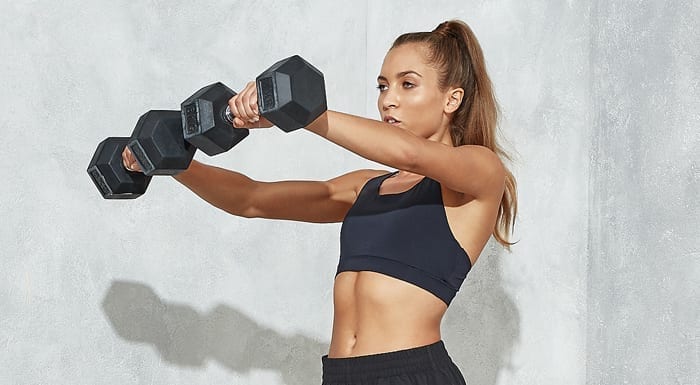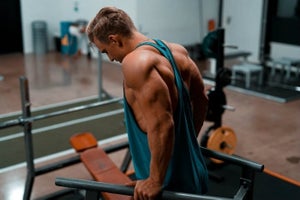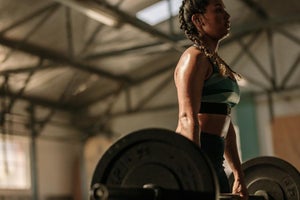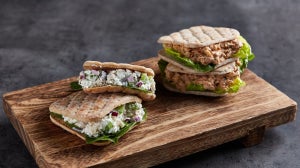
We have the solution for you whether you are just returning or still relying on your home workouts with a full-body workout, top to bottom.
What you’ll need
- Space — You're likely to have your own little bubble of space in the gym and at home, you will need a small amount of space to fulfil your workout in.
- Dumbbells — You're obviously going to need your set of dumbbells for this workout but nothing more.
- Bench — A bench will be beneficial however, you can work around this if not possible.
Full-Body Dumbbell Workout
1. Arnold Dumbbell Press
- Hold a dumbbell in each hand with your arms bent, as in the top of a biceps curl, so your palms are facing you
- Spread your arms out laterally, press your arms up and twist your hands so your palms face forwards. Finish by pushing your head forwards and reaching as high as you can so your biceps are close to your ears.
2. Incline Dumbbell Bench Press
- Set an adjustable bench to an incline of 30-45 degrees.
- Lie on your back on the bench and hold a pair of dumbbells directly above your shoulders with your arms fully extended.
- Pull your shoulder blades together, and slightly stick out your chest.
- Lower both dumbbells to the sides of your chest.
- Pause, and then press the dumbbells back to the starting position.
3. Dumbbell Bent-Over Row
- Bend over at about a 45-degree angle. Keep the back and neck straight throughout the exercise.
- Lift the weights straight up, exhaling and squeezing the shoulder blades together.
- Lower the weights in a controlled manner while inhaling.
- Remain bent over until all reps are done.
4. Dumbbell Pullover
- Lay sideways on the bench so that only your upper back is on the bench.
- Brace yourself with your feet.
- Take the dumbbell in both hands.
- Keep your arms straight and hold the dumbbell over your chest.
- Keeping your arms straight bring the dumbbell back behind your head.
- Then bring it back over the top of your chest. This completes one repetition.
5. Dumbbell Squats
- Hold a pair of dumbbells with arms fully extended next to your sides, with palms facing each other.
- Place your feet shoulder-width apart, with your toes pointed outward.
- Brace your abs, push your hips back and bend your knees, lowering the body into a squat with your hands remaining next to your sides.
- Pause at the bottom, and then push back up to the starting position
6. Dumbbell Swing
- Start with your feet wider than hip-width (wide enough for you to comfortably sing a dumbbell)
- Start with a couple of smaller reps to build up a rhythm
- When the dumbbell swings back between your legs keep your back straight and hinge at the hip with only a small bend in the knee
- The movement comes from your hips rather than your back so keep your back straight throughout
- Your glutes will be the driving force of the swing so squeeze your glutes at the bottom of the swing and drive the dumbbell to shoulder height
- Swings should be continuous and each rep should flow after the previous rep.
Choosing the right weight — how heavy should your dumbells be?
Beginners
Pick a lighter, easier weight to begin with as form is essential. Start off with a manageable weight and a rep range of 8-10 over 3-4 sets. This will allow you to perfect your technique in order to build a solid foundation. Aim for rest periods of 60-90 seconds.
Strength & Endurance
Find yourself a weight that can hit a rep range of 12-15. If you go over 15, it is to light, under 12, it is too heavy. The progressive overload principle again takes a front seat however, we adjust the sets and reps and now work at a heavier weight. Look at 4-6 reps on a set range of 5-6.Your calories will need to support this again with a small surplus to aid the gain of strength and recovery. With this method muscle gain will also be seen. Look for a rest period of 2-3 minutes for full recovery which allows you to perform your best technique.
Build Muscle
This is where you get to up the intensity and weight a little to push your boundaries. With a rep range of 10-12 over 4 sets, you now need to push that progressive overload principle and really push your body. Make should your calories are in a sustainable surplus to support this. Rest periods should vary between 90 seconds to 2 minutes. This allows you to perform at your best on each set.
FAQs
1. Can you gain muscle mass with only dumbbells?
You can, but this depends on your training and ability to overload with the equipment available. You may see a plateau though and if you do, don’t get disheartened, just find new ways of making it harder.
2. Can I use dumbbells every day?There are no issues using the dumbells every day, just make sure you're taking your rest days.
3. Can dumbbells help you lose weight?Yes. Dumbbells can help achieve any goal but it is the training method, weight, sets and reps that determine the outcome to your goals.
4. How heavy should dumbbells be?
As heavy as you need them to be for your specific goal. As you progress in your training you will likely require an increase in weight but only you yourself can judge this and I recommend tracking your training and weight lifted to be able to progress.
5. Are 10kg dumbbells enough to build muscle?
There is only so far you can progress with low weight — no matter how intense you make it. Your muscle-building is likely to plateau unless you can increase the weight as you get stronger when you train.









